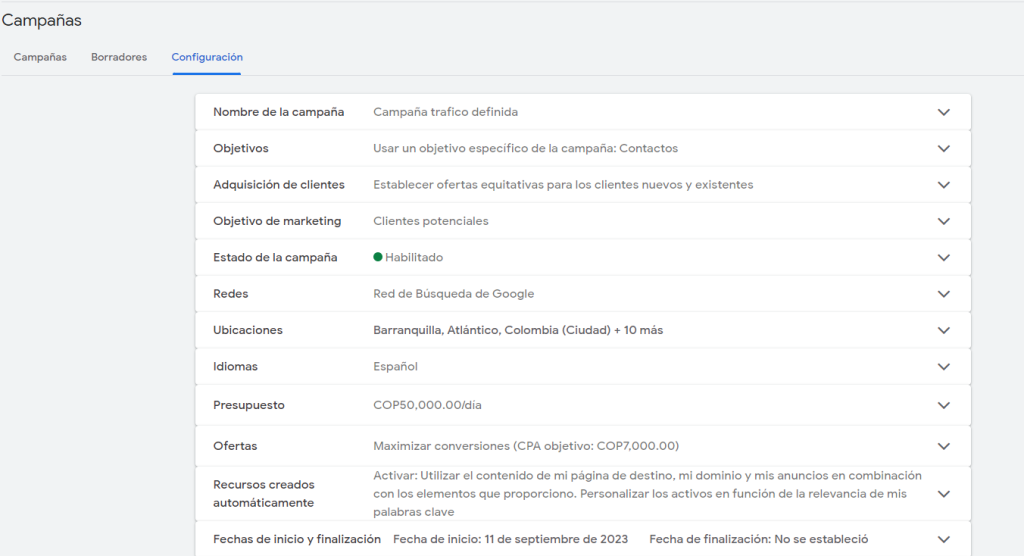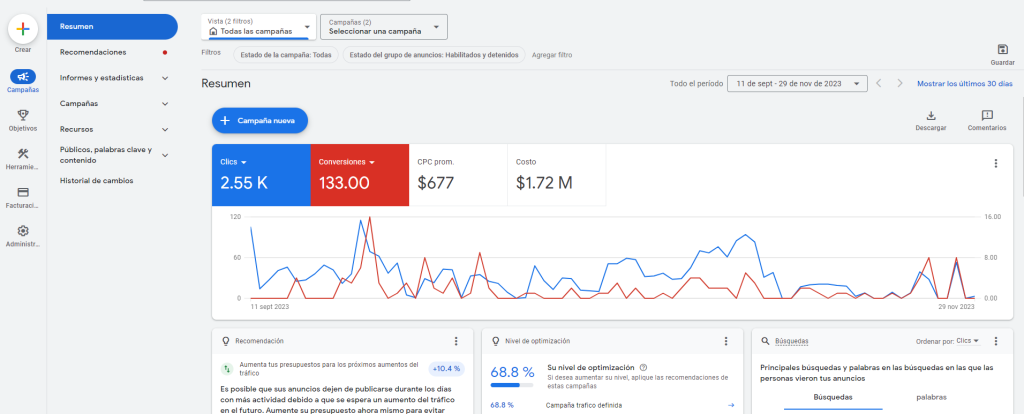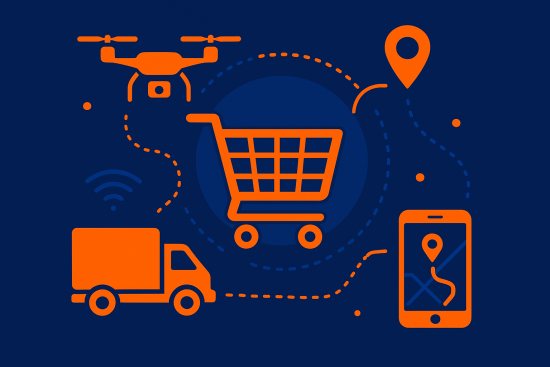
Table of Contents
Google Ads strategies have become an essential component to boost the performance of online stores. We will tell you how specific strategies can boost your digital presence and increase visits to your e-Commerce platform.
How Google Ads works
Google, as well as on other partner websites and platforms. It uses a pay-per-click (PPC) advertising model, where advertisers bid on specific keywords so that their ads appear when users perform related searches. It offers e-Commerce businesses the opportunity to reach their target audience effectively.
Advantages of Google Ads
- Improve your online sales performance:
Increase your sales by connecting with buyers at various points and increase both traffic and transactions on your site. - Increase in-person traffic to your store:
Direct consumers' attention to your physical store, generating a significant boost in traditional sales. - Increase the visibility of your brand:
Strategically showcase your brand to reach a wider audience, thus promoting awareness and participation. - Attract high quality consumers and optimize conversions:
Maximize the quality of your leads and perfect the conversion process. - Boost the promotion of your application among new users:
Advertise your app specifically to relevant users, encouraging downloads and engagement to drive your app's growth.

Keyword selection as a strategy
Techniques for identifying effective keywords
Determining the right keywords is essential for an effective Google Ads E-commerce strategy. Here are some tips to help you select keywords wisely:
- Understand your AudienceResearch your target audience thoroughly: How would they describe your products or services? Use language that will resonate with them.
- Analyze the CompetitionLook at the keywords your competitors are using. This can provide you with insights and reveal opportunities you may have overlooked.
- Use Keyword Research ToolsTake advantage of tools such as Google Keyword Planner to get keyword suggestions and traffic estimates. Other popular tools include SEMrush, Ahrefs y Ubersuggest.
- Prioritize Purchase KeywordsFocus on keywords that indicate a purchase intent, such as "buy", "offer", "discount" or product-specific terms.
- Use Long Tail TermsDon't limit yourself to generic keywords. Incorporate long tail terms (more specific and detailed) that align with particular products or specific user needs.
- Consider SeasonalityAdjust your keyword strategy according to seasonal trends. You can adapt them for specific campaigns, promotions or events.
- Testing Different Types of CoincidenceExperiment with exact, phrase and broad matches to see which works best for your audience and budget. Exact match can be crucial for targeting highly specific customers.
- Performs Constant A/B TestingDon't settle for a static list of keywords. Perform A/B tests regularly to identify new opportunities and improve the performance of your ads.
- Use Negative KeywordsDefine also negative keywords to avoid that your ads are displayed on irrelevant searches. This helps to improve the quality of your clicks.
- Optimize for PerformanceMonitor the performance of your keywords and adjust your strategy accordingly. Eliminate those that do not generate results and increase the bidding for those that do.
- Integrate Keywords into Site ContentMake sure that the selected keywords are naturally integrated into the content of your website. This contributes to greater consistency and relevance.
User search intent analysis
Specificity becomes vitally important, what does your audience really want when they perform a search related to your products or services?
- Practical examplesIf you have a clothing store, the keyword "jacket" may have different intentions behind it. By adding specific terms such as "winter" or "raincoat", you can target users with more specific needs.
- Analysis toolsUse analytics tools to better understand how people interact with your site after performing specific searches. Google Analytics and conversion tracking tools are essential.
- Google Trend ToolsLeverage Google Trends to identify patterns and fluctuations in searches related to your industry. This allows you to adjust your approach according to seasons, events or changes in consumer behavior.
- Seasonal evaluationIf you offer products or services subject to seasonality, such as seasonal fashion or vacation products, adapt your keywords accordingly. For example, "summer dresses" may be more relevant at certain times of the year.
- Ad customizationTailor your ad content to reflect user intent. Use messages that resonate with their specific needs and desires, thus increasing relevance and the likelihood of conversion.
- Continuous adjustmentsAs trends and user intent evolve, don't forget to make continuous adjustments to your campaigns. This involves adding new keywords, modifying bids and adapting strategies as needed.

Optimizing Campaigns for Maximum Performance
- Targeting with groups and adsCreate specific ad groups that align with the different categories of products or services you offer. For example, if you sell clothing and accessories, you can have separate ad groups for "shirts", "pants" and "accessories".
- Dynamic bid adjustmentAlso called bid adjustment, it refers to the amount of money you are willing to invest each time someone clicks on your ad. Not all keywords have the same value for your business. Use the bid adjustment to increase or decrease it according to the importance of each keyword. Those that generate more conversions may deserve a higher bid to ensure higher visibility.
- Strategic ad schedulingOptimize the scheduling of your ads to show them at times when your target audience is most active. Analyze performance data to identify peak traffic days and times and adjust your scheduling accordingly.
Use of Ad Extensions and A/B Testing
Ad Extensions for Additional Information
Extensions are managed directly from the Google Ads interface. They offer a valuable opportunity to provide additional information to your potential customers. Use site, call and location extensions to improve visibility and provide details that can influence the purchase decision.
A/B Testing for Continuous Improvement
A/B testing is essential for ongoing optimization. Experiment with different variations of your ads, from text changes to images and calls to action. Analyze the results to identify which elements resonate best with your audience and make adjustments accordingly.
Customer Feedback Integration
Take advantage of review extensions to highlight positive comments from previous customers. This not only adds credibility to your ads, but can also positively influence the purchasing decision.
Use of Dynamic Ads and Remarketing
Implementation of Dynamic Ads for Products
Dynamic Ads is a powerful tool that allows you to automatically customize your ad content based on past user behavior on your website. Here are some effective tactics for implementation:
-
Product Feed Configuration: Make sure you have a well-structured product feed that includes detailed information about your products, such as images, prices and descriptions.
-
Specific Segmentation: Use segmentation to target Dynamic Ads to users who have visited specific product pages. This ensures that ads are highly relevant to their interests and increases the likelihood of conversion.
-
Dynamic Personalization: Take advantage of dynamic personalization capabilities to show users exactly the products they have seen on your site. This creates a consistent and engaging advertising experience.
Effective Remarketing Tactics to Increase Conversions

Remarketing is a powerful strategy that allows you to reconnect with users who have previously interacted with your website. Here are effective tactics to maximize its impact:
-
Strategic Segmentation: Divide your audience into segments based on their behavior on your site. You can create segments for users who abandoned the shopping cart, visited specific pages or interacted with special offers.
-
Personalized Ads: Create ads that are specific to each segment of your audience. For example, you can offer special discounts to those who abandoned the shopping cart, encouraging them to complete the purchase.
-
Frequency of Announcements: Control the frequency with which your ads are shown to users. Avoid saturation, as too many ads can be counterproductive.
-
Use of Display Ads: Combine Remarketing with display ads to keep your brand present in users' minds. Visual ads can be especially effective in reinforcing brand awareness.
Effective implementation of Google Ads strategies for e-commerce, such as user intent analysis, the use of dynamic ads and remarketing, and constant campaign optimization, is crucial to stand out in the competitive world of e-commerce. Deep audience understanding and adaptability to search trends are key pillars, while advanced tactics such as dynamic ads and remarketing offer opportunities to personalize the user experience and drive conversion. However, the work doesn't stop there; constantly monitoring results and making ongoing adjustments are essential to maintain and improve performance over time.
We recognize the importance of a solid and reliable infrastructure. At ClickPanda, we not only understand the need for effective advertising strategies, but also the importance of having a robust technological foundation. We specialize in empowering every aspect of your online presence, ensuring that your site runs efficiently and reliably. Discover how ClickPanda can be the perfect partner for your digital success.







